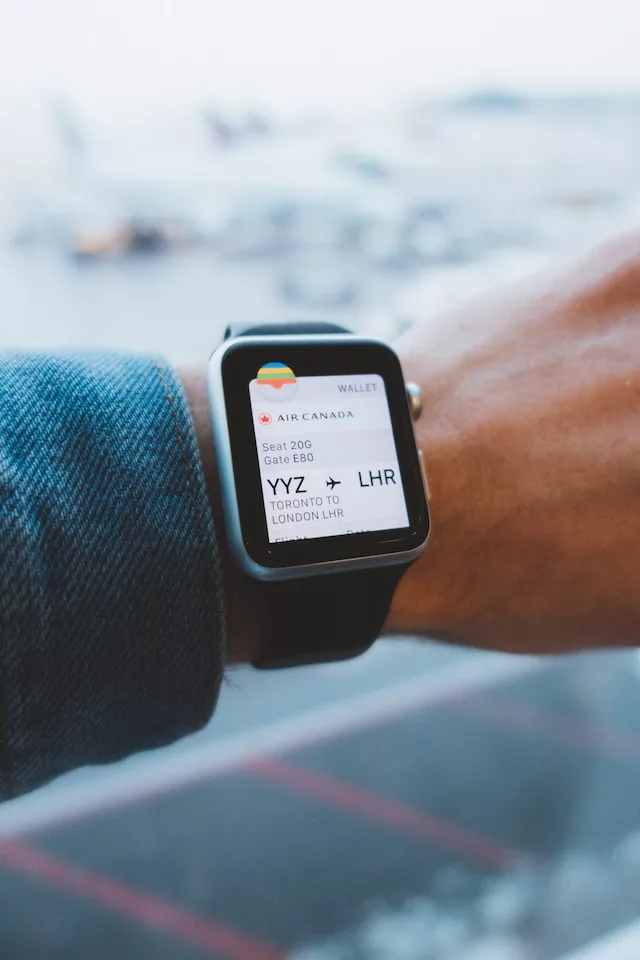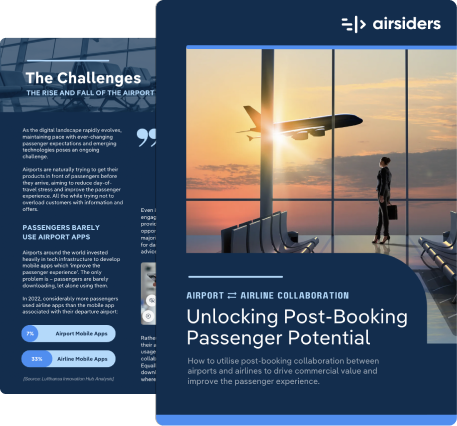How Airports and Airlines Can Collaborate to Improve the Post-Booking Experience
The aviation sector is undergoing a technological renaissance, with the post-booking phase becoming a pivotal period for enhancing passenger experiences and driving business growth.
In this blog post, we'll delve into:
- Technological Synergy: The intersection of digital innovation and the aviation industry is crafting new avenues for improving the passenger journey.
- Strategic Collaboration: Airports and airlines have a unique opportunity to collaborate post-booking to optimize efficiency and elevate the customer experience.
- Revenue Generation: The post-booking phase is ripe with potential for ancillary revenue through tailored services and offers.
- Passenger Satisfaction: A seamless post-booking experience is key to achieving higher levels of passenger satisfaction and loyalty.
We will also explore strategies that enable airports and airlines to:
- Leverage Data Effectively: By sharing and utilizing data, airports and airlines can create a more personalized and stress-free experience for passengers.
- Integrate Digital Platforms: Unifying digital services offers a cohesive journey for travelers, simplifying processes like wayfinding and boarding.
- Adapt to Changing Expectations: As passenger needs evolve, so must the services provided by the aviation industry. We will examine how leading companies are staying ahead of the curve.
Drawing from insights within the Airsiders eBook and the latest industry trends, this article will serve as an additional guide for airline and airport management looking to capitalize on these post-booking opportunities.

1. The Challenges
Navigating the complexities of the post-booking phase, airports and airlines confront various challenges that, if addressed, could significantly elevate the passenger experience.
In 2022, ACI World and SITA's Airport IT Insights Survey highlighted the acceleration of digitalization in airport operations due to the rapid recovery of air travel.
This includes significant investments in self-service technologies and biometrics, emphasizing the urgent need for airports to adopt smart technologies to enhance the passenger experience and address workforce challenges.
Fragmented Digital Engagement
In a digital-based economy, the need for comprehensive engagement is paramount. However, airports and airlines often miss the mark because of:
- Underutilized Airport Apps: AirportCompass's research underscores a striking underuse of airport-specific applications. This represents a missed opportunity for direct engagement and service personalization.
- Overlapping Communications: Passengers are frequently overwhelmed by disjointed messages from multiple travel stakeholders, leading to confusion and a fragmented journey experience.
Data Utilization and Integration
Data is the lifeblood of modern digital strategies, yet its potential remains largely untapped in the aviation sector:
- Data Silos: A siloed approach to data handling stifles the ability to offer a cohesive travel narrative, causing frustration and inefficiencies.
- Proactive vs. Reactive Engagement: The industry often lags, reacting to situations instead of using predictive analytics to preempt passenger needs and preferences.
Operational Cohesion
The harmonization of operational practices between airlines and airports is essential, yet challenging:
- Divergent Priorities: Airlines prioritize the in-flight experience, while airports focus on ground operations. This lack of synergy leads to a disjointed passenger experience.
- Service Delivery Variability: Inconsistencies in service standards between different airlines and airports can create a confusing and sometimes negative perception among passengers.
To tackle these challenges, a paradigm shift is needed—embracing digital transformation and fostering cross-sector collaboration are not just innovative strategies, they're imperatives for survival and growth in the aviation industry.

2. Passenger Journey: The Post-Booking Opportunity
From the moment a passenger books a flight, a window opens for airports and airlines to engage and add value to the travel experience.
With the push towards digitalization, more airports are prioritizing self-service initiatives, with 86% planning to implement self-check-in and self-bag-drop by 2025 (according to SITA's Air Transport IT Insights 2022 report) . The adoption of a single biometric token across all touchpoints exemplifies the industry's commitment to a seamless travel experience.
Recent trends show a surge in airports implementing self-service and biometric systems. For instance, Emirates has introduced a biometric path at Dubai International Airport, allowing passengers to navigate through various checkpoints using facial and iris recognition, demonstrating an innovative approach to post-booking passenger processing.
Likewise, Korean Air is integrating machine learning to forecast passenger and cargo demand, improving customer service and operational decision-making. Similarly, Narita International Airport is incorporating AI and robotics to enhance business efficiency and analyze customer feedback for improved satisfaction.
Tailoring the Travel Narrative
Effective communication during the post-booking phase can significantly enhance passenger satisfaction:
Customized Itineraries: Through intelligent use of data, airports and airlines can craft personalized itineraries, aiding passengers with tailored information, from wayfinding to boarding.
Real-Time Updates: Dynamic communication mechanisms that deliver real-time updates about flights, terminal changes, and boarding details reduce anxiety and build trust.
Unlocking Commercial Potential
The period after booking is ripe for commercial engagement, offering a suite of opportunities for revenue generation:
Personalized Offers: By analyzing passenger data, airports and airlines can present curated offers, from duty-free shopping deals to premium lounge access, directly aligning with individual preferences.
Loyalty Incentives: Innovative loyalty schemes can be introduced or upsold during this phase, fostering long-term customer relationships and repeat business.
Alleviating Travel Stress
Minimizing stress is key to improving the travel experience, and technology plays a central role.
- Digital Wayfinding Solutions: Platforms like those developed by AirportCompass can revolutionize airport navigation, leading to a more relaxed and confident passenger.
- Streamlined Processes: By leveraging technology for expedited check-ins and security procedures, passengers can enjoy a smoother and more efficient airport experience.
By optimizing these post-booking touchpoints, the aviation industry can not only drive incremental revenue but also solidify passenger loyalty through superior service delivery.

3. Wayfinding Case Study: Rome Airport
When it comes to enhancing the post-booking experience, practical examples offer the best insights. Rome Airport's partnership with Airsiders is a prime illustration of how digital wayfinding solutions can be transformative.
Transforming Passenger Navigation
Transforming passenger navigation is not only a matter of convenience but also a strategic imperative for modern airports. It directly impacts the efficiency of airport operations and the quality of the passenger experience.
AirportCompass's Rome Airport wayfinding case study is a testament to this (and featured in our eBook - which you can download here), where the implementation of AirportCompass' technology resulted in a more intuitive and stress-free journey for travelers.
The integration of AirportCompass' wayfinding technology at Rome Airport highlights the pivotal role of digital navigation solutions in revolutionizing the airport experience. AirportCompass' initiative is emblematic of the industry's drive towards digitalization, providing a seamless, stress-free navigation that enhances passenger satisfaction and streamlines airport throughput. This strategic move aligns with the aviation industry's broader vision of a digitally-coordinated environment, where every aspect of the passenger journey is interconnected, leading to more efficient and enjoyable travel experiences.
Operational Benefits
- Increased Efficiency: The streamlined flow of passengers through the airport not only improved the customer experience but also enhanced operational efficiency, reducing congestion and optimizing the use of airport facilities.
- Data Insights: Real-time data on passenger flow allowed for better resource management, from staffing to security, aligning airport operations with actual demand.
The case of Rome Airport demonstrates that strategic partnerships focused on digital solutions not only can solve immediate passenger challenges but also bring long-term operational and commercial benefits.

4. Industry Collaboration to Address Post-Booking Challenges
Cloud services are increasingly central to airport operations, offering scalability for managing passenger volumes and enabling new services. This technological shift is essential for collaborative efforts between airlines and airports to streamline operations and enhance the passenger experience.
Real life examples are becoming more transparent. Airlines are constantly looking to try new ideas to unlock better passenger satisfaction metrics. For example, Qatar Airways and Bangalore International Airport are pioneering the use of the metaverse to offer virtual experiences of airport facilities and onboard environments, setting a new benchmark for immersive customer engagement
The key to unlocking the full potential of the post-booking phase lies in collaboration. By sharing goals and data, airports and airlines can craft a unified experience for passengers.
Data Sharing and Proactive Engagement
- Unified Passenger Profiles: A combined effort to create comprehensive passenger profiles allows for a more personalized journey, with each interaction informed by a deep understanding of individual preferences and history.
- Proactive Information Sharing: By proactively disseminating vital information such as flight delays or gate changes, passengers can adjust their plans accordingly, leading to a more controlled and stress-free experience.
Integrated Ancillary Services
- Unified Digital Platforms: A joint digital platform can offer services ranging from in-flight amenities to airport transfers, creating a seamless experience and driving additional revenue streams.
- Cross-Promotion of Services: Airlines can promote airport services, such as lounge access or fast-track security, to their passengers, while airports can direct travelers to airline-specific offers.
The collaboration between airports and airlines extends beyond mere data exchange; it's about creating a symbiotic ecosystem that thrives on shared success.

5. Airport Innovators and Leading Carriers
To remain competitive, airports and airlines are increasingly adopting innovative approaches to digital engagement.
One airline that has embraced hyper personalisation of the passenger experience is Delta Air Lines. Their Delta Sync program exemplifies end-to-end personalization, offering SkyMiles members personalized inflight entertainment, dining options, and brand partnerships for a more rewarding travel experience.
Leading by Example
- Innovative Airport Apps: Some airports have developed cutting-edge apps that provide everything from indoor navigation to retail offers, setting a new standard in passenger engagement.
- Top Airline Apps: The most successful airline apps offer streamlined booking, check-in, and real-time notifications, becoming an indispensable travel companion.
Digital Pioneers in the Aviation Industry
- Personalization at Scale: Airports and airlines that personalize the travel experience see increased passenger satisfaction and spend per traveler.
- Integrated Customer Journey: By viewing the passenger journey holistically, from home to final destination, industry leaders can identify new opportunities for engagement and service provision.
The aviation industry's digital pioneers are charting a course for the future, where the passenger experience is enhanced at every stage, and collaboration is the engine driving innovation.


